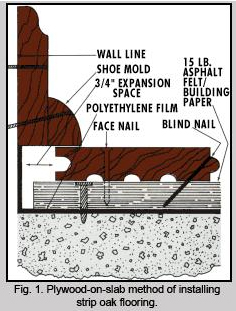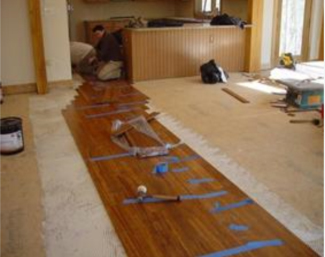Why Choose Solid Bamboo Flooring?
Solid bamboo flooring is a sustainable and durable alternative to traditional hardwood. Bamboo grows much faster than trees, making it an eco-friendly choice. Despite its lightweight appearance, it offers impressive strength, often comparable to oak or maple. The natural grain patterns and warm tones add elegance to any room. Available in various finishes, from light natural hues to darker carbonized options, bamboo flooring fits multiple design styles. Its resistance to moisture and wear makes it suitable for many living spaces.
Preparing for Bamboo Flooring Installation
Proper preparation ensures a smooth installation process for solid bamboo flooring. Start by checking the subfloor for levelness, cracks, or moisture issues. Bamboo requires a stable, dry surface to prevent warping. Acclimate the planks in the room where they’ll be installed for at least 72 hours. Gather necessary tools, including a saw, spacers, tapping block, and underlayment if needed. Measure the space accurately to determine the layout and minimize waste. Taking these steps beforehand helps avoid complications during installation.
Best Installation Methods for Bamboo Flooring
Solid bamboo flooring can be installed using nail-down, glue-down, or floating methods. Nail-down is ideal for wooden subfloors, providing a secure and traditional approach. Glue-down works well on concrete subfloors, ensuring strong adhesion. Floating installations are easier for DIYers, as the planks interlock without nails or glue. Each method has pros and cons, so choose based on your subfloor type and skill level. Proper installation ensures stability, longevity, and a professional-looking finish for your bamboo floors.
Maintaining Solid Bamboo Floors for Longevity
Bamboo flooring is relatively low-maintenance but requires proper care to stay in top condition. Sweep or vacuum regularly to prevent dirt and grit from scratching the surface. Use a damp mop with a mild cleaner designed for bamboo—avoid excessive water, which can cause swelling. Place felt pads under furniture legs to prevent dents. High heels and pet claws can also damage the finish, so consider area rugs in busy zones. With routine upkeep, bamboo floors retain their beauty and durability for years.
Styling Tips for Bamboo Flooring
Bamboo’s natural warmth and texture make it easy to style with various décor themes. For a minimalist look, pair light bamboo floors with neutral furniture and clean lines. Darker carbonized bamboo adds contrast in modern or industrial spaces. In coastal or bohemian designs, layer with woven rugs and light fabrics. The material’s versatility allows it to complement both rustic and contemporary interiors. Experiment with different textures and colors in furniture and décor to enhance the floor’s organic appeal.
Common Mistakes to Avoid During Installation
Installing bamboo flooring incorrectly can lead to costly problems. Skipping acclimation can cause planks to expand or contract after installation. Failing to leave expansion gaps along walls may result in buckling. Using the wrong adhesive or fasteners can weaken the floor’s stability. Cutting planks without proper measurements leads to uneven seams. Rushing the process increases the risk of errors. Taking time to follow best practices ensures a flawless and long-lasting installation.
Cost and Value of Solid Bamboo Flooring
Solid bamboo flooring is generally more affordable than premium hardwoods but offers similar durability. Prices vary based on thickness, finish, and quality. Installation costs depend on the method and whether you hire professionals. While initial expenses may be higher than laminate or vinyl, bamboo’s longevity and eco-friendly appeal add long-term value. It’s a smart investment for homeowners seeking sustainable, stylish, and resilient flooring. Comparing different suppliers and installation options helps find the best balance of cost and quality.
Images about Installing Solid Bamboo Flooring
Installing Solid Bamboo Flooring

How to Install Bamboo Flooring
Installing Bamboo Floors: Must-Know Tips & Tricks
Common Installation Errors With Hardwood & Bamboo Flooring
Cali Bamboo Hardwood Flooring – Tips on Cutting and Installation
Bamboo Flooring Installation, Installing Bamboo Floors, Wholesale
Bamboo Flooring Installation, Installing Bamboo Floors, Wholesale
Related Posts:
- Installing Solid Bamboo Flooring
- Cheap Bamboo Flooring
- Bamboo Flooring Durability Review
- Dark Brown Bamboo Flooring
- Scratch Resistant Bamboo Flooring
- Bamboo Floor Repair Dents
- Bamboo Patio Flooring
- Engineered Bamboo Flooring
- Decorating With Bamboo Floors
- Brown Bamboo Flooring
Installing Solid Bamboo Flooring: A Step-by-Step Guide
Bamboo flooring is an eco-friendly, durable, and attractive option for the home. Although installing solid bamboo flooring can be challenging, with the right tools and a bit of patience, it can be done easily and with minimal effort. In this guide, we’ll provide a step-by-step guide on how to install solid bamboo flooring in your home.
What You Need for Installing Bamboo Flooring
Before you begin installing your bamboo flooring, you’ll need to make sure you have all the necessary items for the job. Depending on the type of bamboo flooring you have, you may need different tools and materials.
At a minimum, you will need the following items:
– Bamboo floor boards
– Underlayment
– Nails or staples
– Hammer
– Saw
– Trowel
– Measuring tape
– Chalk line
– Caulk gun
– Caulking
– Spacers
– Tapping block
– Pull bar
– Utility knife
Preparing Your Subfloor
Before you begin installing your bamboo flooring, you’ll need to prepare your subfloor. This is an important step as it will ensure that your bamboo flooring is properly supported and even. Start by making sure that your subfloor is clean and free of debris. Inspect the subfloor for any bumps or lumps that could interfere with the installation of your bamboo flooring. If you find any bumps or lumps, use a sander to level out the surface.
Once your subfloor is clean and even, lay down the underlayment. This is an important step as it will provide cushioning for your bamboo flooring and help reduce noise when walking on it. Make sure that the underlayment is properly sealed around the edges with tape or caulk.
Installing Your Bamboo Flooring
Now that your subfloor is prepared, it’s time to start laying down your bamboo flooring. Start by laying out your first row of bamboo floorboards along one wall in your room. Make sure that the boards are spaced evenly and securely nailed or stapled in place. Once you have laid out the first row, use a measuring tape to measure out the distance between each board. This will ensure that all of your boards are spaced evenly throughout your room.
Once the first row is installed, continue laying out rows of boards until all of your boards are installed in your room. To ensure a secure fit, use spacers between each board and use a tapping block to secure them in place. Once all of your boards are in place, use a pull bar to ensure that all of the boards are tight and secure.
Finally, use a utility knife to trim off any excess material around the edges of your room. Once this is done, caulk any gaps between boards or along walls to seal them off from dust and dirt. Your bamboo flooring installation is now complete!
What type of tools do I need for installing bamboo flooring?
You will need a hammer, saw, trowel, measuring tape, chalk line, caulk gun, caulking, spacers, tapping block, pull bar, and utility knife for installing bamboo flooring.
How do I prepare my subfloor before installing bamboo flooring?
Begin by making sure that your subfloor is clean and free of debris. Inspect the subfloor for any bumps or lumps that could interfere with the installation of your bamboo flooring. If you find any bumps or lumps, use a sander to level out the surface. Once your subfloor is clean and even, lay down the underlayment and make sure it is properly sealed around the edges with tape or caulk.





